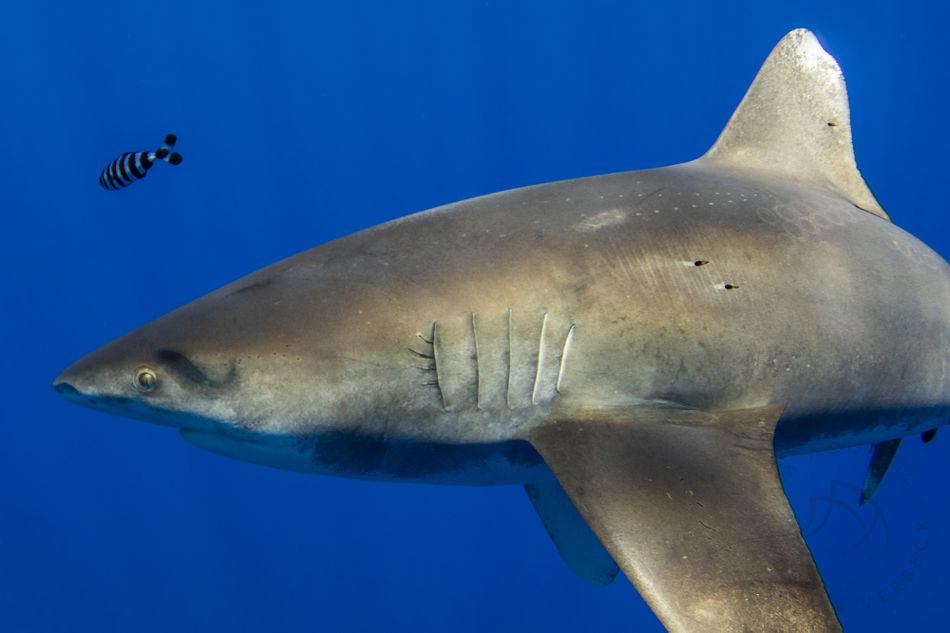An underwater photographer snapped a curious picture of a shark off of Kona, Hawaii, in November 2019. The oceanic whitetip shark had unusual, ring-like markings on its body.
The photographer, Deron Verbec, passed the images to Yannis Papastamatiou, a shark researcher and predator ecologist at Florida International University. These telltale scars almost certainly came from a large squid, Papastamatiou and his research team concluded in a study published last week in the Journal of Fish Biology. Though, critically, there’s not enough evidence to definitively say it was a giant squid — the huge, elusive deep sea species only documented on video twice.
Regardless, the photos provide compelling evidence of an underwater tussle between a big shark (around six feet long) and a large squid, revealing a deep sea wilderness that us land-dwellers still don’t know much about.
“It goes to show you there’s crazy stuff going on down there,” Papastamatiou told Mashable.
Indeed.
“It’s the majesty of nature,” Nathan Robinson, a researcher at the Oceanogràfic Foundation, a marine conservation organization, told Mashable. “This idea of a huge shark battling a huge squid is so primordial,” added Robinson, who had no role in the research. In 2019, Robinson helped capture rare footage of a giant squid.
In the images below, ring-like marks from the suckers on a squid’s arms can be seen on the shark’s back (near the dorsal fin), along with lines of smaller dots, which could be marks left by smaller arms and suckers. “I can’t think of anything else except for a large squid that could make those circular marks,” Michael Vecchione, a cephalopod expert at the Smithsonian Institution who also had no role in the study, told Mashable.

An oceanic whitetip shark with telltale scarring.
Image: Deron Verbec

Another view of the whitetip shark.
Image: Deron Verbec
The suckers are tenacious, with little teeth-like structures around the suction cup-like suckers. “That can cut into a shark’s skin and leave an imprint,” said Robinson.
And these are sizable imprints. “A pretty big animal made those markings,” noted Papastamatiou.
It’s impossible to know what exactly happened in the dark waters, perhaps some 3,000 feet down. Papastamatiou suspects the oceanic whitetip shark, a species known to regularly eat smaller squids, might have been the aggressor in this interaction. Perhaps the squid successfully defended itself against the shark in a fierce, brief struggle.
“You have an opportunistic species who was cruising through the oceans, saw a big squid, and had a go,” said Robinson. “Then you have the defensive response of the squid wrapping its arms around and trying to break free.”
There are a number of large squid species in that region of the Pacific, including the giant squids, which may hunt at some 2,500 feet down. “We can’t say it’s a giant squid, but that’s one of the candidates,” said Papastamatiou. A “small” giant squid, like the one filmed in the Gulf of Mexico in 2019, is some 10 to 12 feet long. Big ones can grow some 40 feet long. The species also might have been a big flying squid or a glass squid perhaps some 6.5 feet (two meters) in length, noted Vecchione.
“It’s the majesty of nature.”
Somewhere in the depths, perhaps around the limit of the shark’s dive and the squid’s hunting region, the two predators likely met by chance. “The evidence leads us to believe that whatever happened, happened down deep,” said Papastamatiou, as large squids often live in deeper waters.
Most of the ongoings in the deep sea remain mysterious. The dark realm extending some 660 to 3300 feet below the surface — a place called the twilight zone — is one of the largest habitats on Earth. Yet little is known about what happens there. Battles between sharks and squids? Sure.
“There’s a lot happening that we don’t have a good understanding of,” said the Smithsonian’s Vecchione. “It’s such an unexplored area.”
“We’ve barely scratched the surface of what’s there,” added Robinson.
But there’s now compelling evidence of a battle between two big predators. “Those are pretty definitive markings,” Edie Widder, a marine biologist who captured the first-ever footage of a giant squid, told Mashable over email. “You can almost see the struggle, can’t you?”
“I wish we could capture that on camera,” said Robinson.
